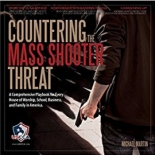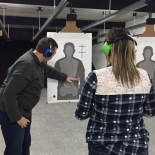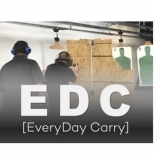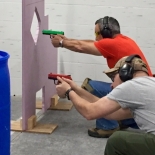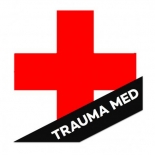Training
Training for Places of Worship
Would it surprise you to hear us say that firearms training is not the most important thing when it comes to church security? 22three’s safety team training uses industry best practices to increase safety of individuals and families and respond to real-world threats with valuable skills in prevention and deterrence; conflict avoidance and de-escalation; protection and crisis response.
While we are a firearms training entity that holds a variety of classes and private training sessions multiple times each week, we would rather you deter and avoid a violent encounter than be in one – so our training starts there.
And, yes, this training is equally valuable for businesses, schools, and anyone who spends time in public places. For more about these or any of our training programs, contact wendy@22three.com.
22three’s Training for Places of Worship Includes:
- Biblically- and Legally-Sound Force Decisions
- Observe and Orient: Situational Awareness & Behavior Cues
- Effect Verbal Interactions & De-Escalation
- Physical Positioning & Control
- Concealing in an Official Capacity
- After Mathematics
Not ready for a full training program? Check out Church Security Lite at the bottom of this page.
For more about 22three’s bedrock training for places of worship, keep reading:
Biblically- and Legally-Sound Force Decisions
This two-hour, foundational session explores morality and law related to self-defense and defense of others. In addition to communicating and clarifying the latest in Ohio and US law, we discuss how the political, social, and prosecutorial landscape may impact force decisions. We then have a guided discussion with a leader from your congregation who will provide organizational and theological input to guide force decisions.
Goal: Inform and empower your team to make legally- and Biblically-sound force decisions.
Who: All members of the team and an authoritative congregational leader.
Why: Implement lawful policy to protect your congregation. In addition to staying physically safe, responsible safety team members need to be equipped to keep themselves (and your congregation) morally, legally and financially safe as well.
Observe and Orient: Situational Awareness & Behavior Cues
In this session, we analyze threat vectors – potential avenues or modes that an attacker may employ to exploit a vulnerability and subsequently cause harm to your congregation – taking care to look at all 168 hours in a week, not just the 2-5 hours when the sanctuary is full. Analysis and discussion of active shooter events, domestic violence situations, economic crime, and interactions with help-seekers will help paint a clearer picture of the most likely and most dangerous courses of hostile action. Along with practical exercises, we give practitioners specific tools and techniques to visually “clean” everyone they see. We conclude with an experiential exercise to get a sense of what a worst-case event might feel like.
Goal: Team members will gain a better understanding of and realistic appreciation for both the odds and stakes of violent threats and will learn practical skills to better observe (and therefore respond to) a wider variety of potential scenarios.
Who: All members of the team and an overseeing congregational leader.
Why: Analyze and mitigate threats to the flock.
Effective Verbal Interactions and De-escalation
In this session, we explore the framework of VADAR (Verbal/Auditory Detection and Ranging), using verbal interactions to gauge intentions and create a welcoming environment for all worshipers. Topics for this two-hour session include deflecting abuse, obtaining voluntary compliance, phrasing to include and avoid, and the “verbal bump frisk.” We will conduct role-playing exercises to rehearse verbal interactions and will begin to discuss radio and cellular communication within the team.
Goal: Develop effective verbal and nonverbal communication in both commonplace and crisis situations so your team members will know how to assess and diffuse potentially dangerous situations; promote thoughtful resolution to potentially violent and/or disruptive behavior; minimize the likelihood of the need to use force; and increasing voluntary compliance.
Who: All members of the team.
Why: All members of the team should be equipped to listen to and use words and non-verbal signals to both edify and clarify, and, when needed, better gain control of crisis situations.
Physical Positioning & Control
This crucial session is all about managing space, hands, and access to arms. Topics include angles and positioning; default protective positions; foiling access to tools; limb control; firearm retention; stand-in-base; and two-person strategies. This introductory class on physical positioning and control involves minimal contact and no exertion but should encourage participants to begin or refine their strength and conditioning as well as their combative skillset.
Goal: Be positionally and psychologically prepared to absorb and apply physical force.
Who: All members of the team.
Why: Empowering your team with a variety of force options increases their safety and the safety of your entire congregation.
Concealing in an Official Capacity
This session, which includes live-fire range time, is all about building a superior skillset that shows only when needed. Concealing a gun and employing that concealed gun are skills that must be worked in tandem. Topics include gear selection and testing; four rules of firearms safety applied in dynamic environments; clearing cover garments; safe and efficient reholstering; draw to first shot; and building confidence for tight shots under pressure.
Goal: Improve team members’ on-demand shooting performance in a cognitively-loaded situation. (Be able to surprise the shot out of someone who needs to get shot.)
Who: All armed members of the team (pre-audition or post-audition, depending on organization).
Why: Because carrying and effectively employing a concealed firearm are two different things, this session further increases the safety of your entire congregation.
After Mathematics
This two-hour session communicates valuable information and skills to be employed during or post-incident. Topics include avoiding friendly fire; crowd management; trauma first aid; interacting with first responders; and legal/informational positioning post-incident. Related to trauma care, this class teaches valuable skills, helping prepare students to deal with severe life-threatening injuries or illnesses when seconds count, and EMS personnel and emergency room are minutes (or longer) away. Whether from an active shooter event, hostage situation, bombing or terrorist scenario, learning to quickly assess a patient and handle significant issues such as arterial bleeding, penetrating wounds or chest injuries affecting breathing, and more can buy time and save your life or the lives of others.
Goal: To secure the best possible outcome from the worst-case scenario.
Who: All members of the team and an authoritative congregational leader.
Why: This session will help team members foresee possible post-incident dangers and better prepare for or, optimally, avoid them.
Tactical Firearm Training & Use
For places of worship electing to include an armed component in their security plan, 22three endeavors to hold participants in this training to high standards of safety and proficiency. We recommend your church do the same. In part, we strongly encourage requiring team members to pass the equivalent of the Ohio Police Officer’s Training Academy’s shooting qualification, which we can administer as part of our training with your team. The OPOTA qualification is the same baseline shooting qualification police officers are required to pass in the state of Ohio. At 22three, we pride ourselves in offering training programs that prepare students to succeed by exceeding this bar.
EDC Training Modules
EveryDay Carry (EDC) helps churches further develop a mindset that incorporates awareness and preparedness. Shooting in a lane at a stationary target in a controlled, no-stress situation is great for what it is, but it does not replicate the demands and challenges of a real-world defensive scenario.
Each two-hour EDC class teaches good technique and best practices of important, new skills needed; and 22three is committed to teaching the “why” behind each area so your future practice time is more purposeful and beneficial.
Click the EDC link to the left or here to read about our most common EDC classes. (Note: The “Concealing in an Official Capacity” session or our standard EDC – Holster Draw! class is a prerequisite for the other EDC modules.)
CHURCH SECURITY LITE
Not ready for a full training program for your place of worship? That’s OK. We can help your safety team begin to generate and agree on a game plan through our 4- hour Countering the Mass Shooter Threat seminar. This session provides a critically important foundation, and it’s brimming with invaluable information, outlines and helpful checklists so you can start down the path of increased safety and security for your place of worship.
Additionally, if your team decides to have an armed component to your safety plan, let us run your team members through a non-biased, independent shooting qualification because “I’ve been around guns all my life” is not a quantifiable measure. If you choose to have members of your team conceal carry, you will have peace of mind knowing they have the necessary level of proficiency.
Countering the Mass Shooter Threat Seminar
This foundational seminar will help your safety team get on the same page and begin to develop a plan to deter, detect, respond and mitigate real-world threats to your place of worship, thereby increasing the safety and security of individuals and families at your place of worship.
Goal: Participants will gain knowledge and specific tactics that can be used to thwart active shooters in public spaces, businesses, schools and places of worship. Learn specific physical and non-physical deterrents that can help you prevent a violent incident before it occurs and begin developing an appropriate response plan to be implemented during a violent encounter and a plan to mitigate the threat and save lives.
Who: Groups not sure where to start. Groups that need more information to help ascertain their security path forward.
Why: Because you need more information to make informed decisions moving forward that work for your congregation. We will give you that information.
Find out what has been learned from an in-depth analysis of 165 Active Shooter events since Columbine. You will be given a clear snapshot of these events and specific information to help you prepare to counter and survive an active shooter event. We will address many important topics, which include but are not limited to: gun-free zones and victim responses that make a difference; knowing the signs and creating an emergency plan; and learning specific how-to's so that you are not an easy victim.
OPOTA/FBI Qualification
Goal: By running your security team members through a non-biased firearms qualification course (either FBI or OPOTA, which stands for Ohio Peace Officers Training Academy), you’ll know that your team members possess the right knowledge, skills and attitude to help serve in a safety capacity at your place of worship.
Who: Anyone on your safety team given permission to carry a firearm.
Why: A non-biased, third-party qualification is a valuable training tool in and of itself, and it takes the pressure off your leadership when it comes to approving specific individuals to be part of your security team.
